ENDOCRINE SYSTEM
Role of Hormones in Reproduction:
The primary hormones that regulate reproduction are the steroids such as androgens, estrogens and progesterone which have masculinizing, feminizing and gestational effects respectively. These hormones are secreted from the gonads which are regulated by the anterior pituitary (adenohypophysis). In male and female, reproductive behaviour and reproduction are mainly under the control of LH (Luteinizing Hormone) and FSH (Follicle Stimulating Hormone). LH stimulates the testes to produce androgens, the male sex hormone. Sperms are then actively produced. In man sperm production starts at sexual puberty and may continue throughout his life.
- Follicle Stimulating Hormone (FSH)
FSH in the female influences the development of the Graafian follicle and secretion of estrogens. In the male it is necessary for the development of seminiferous tubules, and for spermatogenesis.
- Luteinizing Hormone (LH)
In the female, it is the hormone necessary for ovulation, and the secretion of the luteal hormone progesterone, and for the final maturation of the Graafian follicle. In the male it stimulates the interstitial (Leydig) cells of testes and the secretion of testosterone, and is referred to as the Interstitial Cell Stimulating Hormone (ICSH).
- Prolactin (PRL) or Lactogenic Hormone
The main function of this hormone is milk secretion during lactation.
- Oxytocin Hormone
Oxytocin causes expulsion of milk from the breast and it is also involved in the contraction of smooth muscles of uterus during child birth.
Reproductive phase of life in Human:
Reproduction is more important for the continuation of human race. The phase in an individual’s life during which there is production of gametes is called reproductive phase. In females, the reproductive phase of life begins at puberty (10 to 12 years of age) and generally lasts till the age of approximately 45 to 50 years, and in males, it is from the age of 13 to life long. The reproductive age may vary from person to person. The following are the reproductive phases in the life of a female.
- Menarche
The first menstrual flow begins at puberty and is termed menarche. The ova begin to mature with the onset of puberty. It is the beginning of adolescence, during which mental and emotional maturation occurs and physical growth becomes pronounced.
- Ovulation
Ovulation occurs approximately 14 days before the next ovarian cycle commences. Thus in a 28 days cycle ovulation occurs about day 14. One ovum matures and is released by one of the ovaries once in about 28 to 30 days. The release of ovum from the ovary is called ovulation. During this period, the wall of the uterus becomes thick so as to receive the fertilized egg. This results in pregnancy.
- Pregnancy
After ovulation the ovum reaches the fallopian tube and fertilization takes place. The fertilized egg undergoes development and it is implanted in the uterus. The corpus luteum continues to grow and produces large amount of progesterone. This results in pregnancy. Normally, it lasts for 280 days, at the end of which parturition takes place.
- Menstruation
If the ovum is not fertilized, the corpus luteum begins to degenerate and the production of hormones progesterone and estrogen ceases. The unfertilized egg and the thickened lining of the uterus along with its blood vessels are shed off. This causes bleeding in woman’s reproductive tract which is called menstruation. Menstruation occurs once in about 28 to 30 days. It takes about 3 to 5 days. In some cases, initially menstrual cycle may be irregular. It takes some time to become regular. If it remains irregular for over a year, then it is better to consult a doctor.
- Menopause
Menopause marks the end of the reproductive phase of a woman’s life. At 45 to 50 years of age, the menstrual cycle stops. Stoppage of menstruation is termed as ‘menopause’. During menopause psychological symptoms such as anxiety, irritability, fatigue and loss of concentration may occur. Menopause may be induced by surgical removal of the ovaries, or by pelvic irradiation in a woman of any age.
Menstrual Cycle:
The beginning of the menstrual cycle marks the onset of puberty in human females. The menstrual cycle begins with the casting off of endometrial lining of the uterus and bleeding. The casting of endometrium can be considered as periodic preparation for pregnancy. Menstruation occurs if an ovum released by the ovary of a woman is not fertilized during ovulation.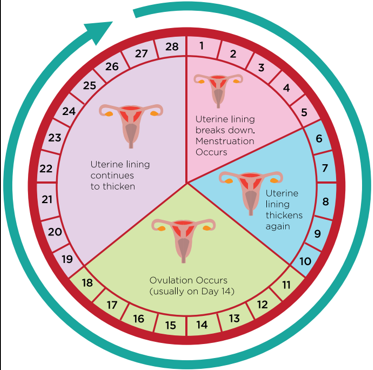
- When a girl reaches puberty at the age of about 10, the sex hormones released into her blood cause some of the ova (or egg cells) in her ovaries to become mature (or ripe).
- Usually one mature ovum (or egg) is released from one of the ovaries into the oviduct once in every 28 days. This is called ovulation.
- Before ovulation (or release of ovum), the inner wall of uterus becomes thick and spongy, and full of tiny blood vessels (or blood capillaries). It prepares itself to receive the fertilized ovum.
- If the ovum does not get fertilized then the thick and soft inner lining of uterus is no longer needed and hence it breaks. So, the thick and soft inner lining of uterus along with the blood vessels and the dead ovum comes out of the vagina in the form of a bleeding called menstruation.
- Menstruation usually occurs 14 days after ovulation and usually lasts for about 3 to 5 days.
- After menstruation is over, the inner lining of the uterus starts building up again so that it may become ready to receive the next ovum.
- If the ovum does not get fertilized even now, then menstruation takes place again. This cycle of menstruation is repeated again and again in women after every 28 days. The menstrual cycle is controlled by hormones.
- Menstruation stops temporarily when the ovum gets fertilized and the women gets pregnant. This is because, in this case the thick and soft lining of the uterus containing lot of blood vessels is needed for the growth and development of the fertilized ovum to form a baby. Menstruation restarts after the birth of the baby. Menstruation also stops due to nutritional deficiencies, low body weight, stress, eating disorder, excessive weight gain etc.
Hypothalamus:
Hypothalamus is a small cone shaped structure that projects downward from the brain ending into the pituitary stalk. It interlinks both the nervous system and endocrine system. Though pituitary gland is known as master endocrine glands that controls the other endocrine glands, but it is, in turn controlled by the hypothalamus. Hypothalamus contains groups of neurosecretory cells. It produces neurotransmitters which regulate the secretions of the pituitary (Figure11. 2). The hormones produced by the hypothalamus act either as a releasing hormone or as an inhibitory hormone.
In the basal region of the brain, the hypothalamic hypophyseal portal blood vessel connects hypothalamus and anterior pituitary. It allows hypothalamic hormones to control anterior pituitary secretion. The posterior pituitary is connected with hypothalamus by a nerve bundle called hypothalamic hypophyseal axis. It produces nerve signal that control the posterior pituitary secretion. Hypothalamus maintains homeostasis, blood pressure, body temperature, cardio and fluid electrolyte balance of the body.
As the part of limbic system it influences various emotional responses.
S.No. | Hormones | Functions |
1 | hyrotropin releasing hormone (TRH) | Stimulates the secretion of TSH |
2 | Gonadotropin releasing hormone(GnRH) | Stimulates the secretion of FSH |
3 | Corticotropin releasing hormone (CRH) | Stimulates the secretion of ACTH |
4 | Growth hormone releasing hormone(GHRH) | Stimulates the secretion of GH |
5 | Prolactin releasing hormone (PRH) | Stimulates the secretion of Prolactin |
6 | Luteinizing hormone releasing hormone (LHRH) | Stimulates the secretion of LH |
7 | MSH releasing hormone | Stimulates the secretion of MSH |
8 | Growth hormone-inhibiting hormone (GHIH) | Inhibits the secretion of GH |
9 | Prolactin inhibiting hormone (PIH) | Inhibits the secretion of Prolactin |
10 | MSH inhibiting hormone | Inhibits the secretion of MSH |
Pituitary Gland:
The pituitary gland or hypophysis is a pea shaped compact mass of cells located at the base of the midbrain attached to the hypothalamus by a pituitary stalk. The pituitary gland is anatomically composed of two lobes and perform different functions. They are the anterior lobe (adenohypophysis) and the posterior lobe (neurohypophysis). The intermediate lobe is non-existent in humans. The pituitary gland forms the major endocrine gland in most vertebrates. It regulates and controls other endocrine glands and so is called as the “Master gland”.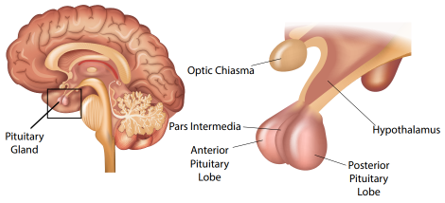
Hormones secreted by the anterior lobe (Adenohypophysis) of pituitary:
The anterior pituitary is composed of different types of cells and secrete hormones which stimulates the production of hormones by other endocrine glands.
- Growth hormone (GH)
GH promotes the development and enlargement of all tissues of the body. It stimulates the growth of muscles, cartilage and long bones. It controls the cell metabolism. The improper secretion of this hormone leads to the following conditions.
Dwarfism: It is caused by decreased secretion of growth hormone in children. The characteristic features are stunted growth, delayed skeletal formation and mental disability.
Gigantism: Oversecretion of growth hormone leads to gigantism in children. It is characterised by overgrowth of all body tissues and organs. Individuals attain abnormal increase in height.
Acromegaly: Excess secretion of growth hormone in adults may lead to abnormal enlargement of head, face, hands and feet.
- Thyroid stimulating hormone (TSH)
TSH controls the growth of thyroid gland, coordinates its activities and hormone secretion.
- Adrenocorticotropic hormone (ACTH)
ACTH stimulates adrenal cortex of the adrenal gland for the production of its hormones. It also influences protein synthesis in the adrenal cortex.
- Follicle stimulating hormone (FSH)
In male, it stimulates the germinal epithelium of testes for formation of sperms. In female it initiates the growth of ovarian follicles and its development in ovary.
- Luteinizing hormone (LH)
In male, it promotes the Leydig cells of the testes to secrete male sex hormone testosterone. In female, it causes ovulation (rupture of mature Graafian follicle), responsible for the development of corpus luteum and production of female sex hormones estrogen and progesterone.
- Prolactin (PRL)
PRL is also called lactogenic hormone. This hormone initiates development of mammary glands during pregnancy and stimulates the production of milk after child birth.
Hormones secreted by the posterior lobe (Neurohypophysis) of pituitary:
- Vasopressin or Antidiuretic hormone (ADH)
In kidney tubules it increases reabsorption of water. It reduces loss of water through urine and hence the name antidiuretic hormone.
Deficiency of ADH reduces reabsorption of water and causes an increase in urine output (polyuria). This deficiency disorder is called Diabetes insipidus.
- Oxytocin
It helps in the contraction of the smooth muscles of uterus at the time of child birth and milk ejection from the mammary gland after child birth.
Thyroid Gland:
The thyroid gland is composed of two distinct lobes lying one on either side of the trachea. The two lobes are connected by means of a narrow band of tissue known as the isthmus. This gland is composed of glandular follicles and lined by cuboidal epithelium.The follicles are filled with colloid material called thyroglobulin. An amino acid tyrosine and iodine are involved in the formation of thyroid hormone.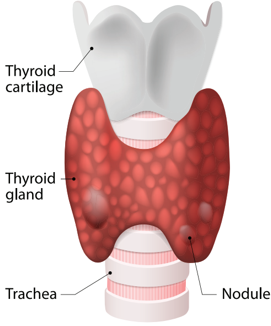
The hormones secreted by the thyroid gland are
- Triiodothyronine (T3)
- Tetraiodothyronine or Thyroxine (T4)
Functions of thyroid hormones
- Production of energy by maintaining the Basal Metabolic Rate (BMR) of the body.
- Helps to maintain normal body temperature.
- Influences the activity of central nervous system.
- Controls growth of the body and bone formation.
- Essential for normal physical, mental and personality development.
- It is also known as personality hormone.
- Regulates cell metabolism.
Thyroid Dysfunction:
When the thyroid gland fails to secrete the normal level of hormones, the condition is called thyroid dysfunction. It leads to the following conditions
- Hypothyroidism
It is caused due to the decreased secretion of the thyroid hormones. The abnormal conditions are simple goitre, cretinism and myxoedema.
- Goitre
It is caused due to the inadequate supply of iodine in our diet. This is commonly prevalent in Himalayan regions due to low level of iodine content in the soil. It leads to the enlargement of thyroid gland which protrudes as a marked swelling in the neck and is called as goitre.
- Cretinism
It is caused due to decreased secretion of the thyroid hormones in children. The conditions are stunted growth, mental defect, lack of skeletal development and deformed bones. They are called as cretins.
- Myxoedema
It is caused by deficiency of thyroid hormones in adults. They are mentally sluggish, increase in body weight, puffiness of the face and hand, oedematous appearance.
- Hyperthyroidism
It is caused due to the excess secretion of the thyroid hormones which leads to Grave’s disease. The symptoms are protrusion of the eyeballs (Exopthalmia), increased metabolic rate, high body temperature, profuse sweating, loss of body weight and nervousness.
Parathyroid Gland:
The parathyroid glands are four small oval bodies that are situated on the posterior surface of the thyroid lobes. The chief cells of the gland are mainly concerned with secretion of parathormone.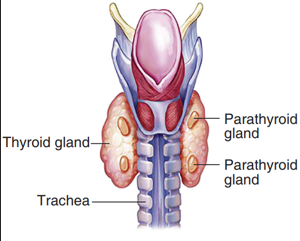
Functions of Parathormone
- The parathormone regulates calcium and phosphorus metabolism in the body.
- They act on bone, kidney and intestine to maintain blood calcium levels.
Parthyroid Dysfunction
- Muscle spasm known as Tetany (sustained contraction of muscles in face, larynx, hands and feet).
- Painful cramps of the limb muscles.
Pancreas (Islets of Langerhans):
Pancreas is an elongated, yellowish gland situated in the loop of stomach and duodenum. It is exocrine and endocrine in nature. The exocrine pancreas secretes pancreatic juice which plays a role in digestion while, the endocrine portion is made up of Islets of Langerhans.
The Islets of Langerhans consists of two types of cells namely alpha cells and beta cells. The alpha cells secrete glucagon and beta cells secrete insulin.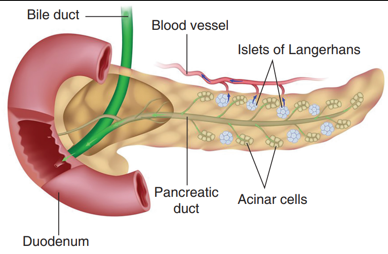
Functions of Pancreatic hormones
A balance between insulin and glucagon production is necessary to maintain blood glucose concentration.
- Insulin
- Insulin helps in the conversion of glucose into glycogen which is stored in liver and skeletal muscles.
- It promotes the transport of glucose into the cells.
- It decreases the concentration of glucose in blood.
- Glucagon
- Glucagon helps in the breakdown of glycogen to glucose in the liver.
- It increases blood glucose levels.
iii. Diabetes Mellitus
- The deficiency of insulin causes Diabetes mellitus. It is characterised by
- Increase in blood sugar level (Hyperglycemia).
- Excretion of excess glucose in the urine (Glycosuria).
- Frequent urination (Polyuria).
- Increased thirst (Polydipsia).
- Increase in appetite (Polyphagia).
Adrenal Gland:
The adrenal glands are located above each kidney. They are also called supra renal glands. The outer part is the adrenal cortex and the inner part is the adrenal medulla. The two distinct parts are structurally and functionally different.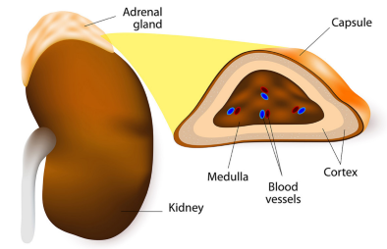
Adrenal Cortex
The adrenal cortex consists of three layers of cells. They are zona glomerulosa, zona fasciculata and zona reticularis. The hormones secreted by the adrenal cortex are corticosteroids. They are classified into Glucocorticoids and Mineralocorticoids.
Functions of adrenocortical hormones
- Glucocorticoids
- The glucocorticoids secreted by the zona fasciculata are cortisol and corticosterone
- They regulate cell metabolism.
- It stimulates the formation of glucose from glycogen in the liver.
- It is an anti-inflammatory and anti-allergic agent.
- Mineralocorticoids
- The mineralocorticoids secreted by zona glomerulosa is aldosterone
- It helps to reabsorb sodium ions from the renal tubules.
- It causes increased excretion of potassium ions.
- It regulates electrolyte balance, body fluid volume, osmotic pressure and blood pressure.
Adrenal Medulla
The adrenal medulla is composed of chromaffin cells.They are richly supplied with sympathetic and parasympathetic nerves. It secretes two hormones namely Epinephrine (Adrenaline) and Norepinephrine (Noradrenaline).
They are together called as “Emergency hormones”. It is produced during conditions of stress and emotion. Hence it is also referred as “flight, fright and fight hormone”.
Functions of adrenal medullary hormones:
- Epinephrine (Adrenaline)
- It promotes the conversion of glycogen to glucose in liver and muscles.
- It increases heart beat and blood pressure.
- It increases the rate of respiration by dilation of bronchi and trachea.
- It causes dilation of the pupil in eye.
- It decreases blood flow through the skin.
- Norepinephrine (Noradrenalin)
Most of its actions are similar to those of epinephrine.
Thymus Gland:
Thymus is partly an endocrine gland and partly a lymphoid gland. It is located in the upper part of the chest covering the lower end of trachea. Thymosin is the hormone secreted by thymus.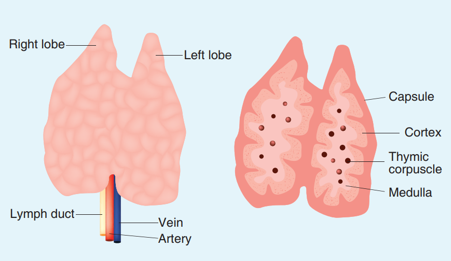
Functions of Thymosin
- It has a stimulatory effect on the immune function.
- It stimulates the production and differentiation of lymphocytes.
Pineal gland:
In human, the pineal gland or epiphysis cerebri or conarium is located behind the third ventricle of brain and is formed of parenchymal cells and interstitial cells. It secretes the hormone, melatonin, which plays a central role in the regulation of circadian rhythm of our body and maintains the normal sleep wake cycle. It also regulates the timing of sexual maturation of gonads. In addition melatonin also influences metabolism, pigmentation, menstrual cycle and defence mechanism of our body.
Plant Hormones:
Plant hormones are organic molecules that are produced at extremely low concentration in plants. These molecules control morphological, physiological and biochemical responses.
Types of Plant Hormones:
- Auxins
Auxins (Gk. auxein = to grow) were the first plant hormones discovered. The term auxin was introduced by Kogl and Haagen-Smith (1931). Auxins are produced at the tip of stems and roots from where they migrate to the zone of elongation. Charles Darwin (1880), observed unilateral growth and curvature of canary grass (Phalaris canariensis) coleoptiles. He came to the conclusion that some ‘influence’ was transmitted from the tip of the coleoptile to the basal region. This ‘influence’ was later identified as Auxin by Went.
Physiological effects of auxins:
- Auxins promote the elongation of stems and coleoptiles which makes them to grow.
- Auxins induce root formation at low concentration and inhibit it at higher concentration.
- The auxins produced by the apical buds suppress growth of lateral buds. This is called apical dominance.
- Seedless fruits without fertilization are induced by the external application of auxins. (Parthenocarpy). Examples: Watermelon, Grapes, Lime etc.
- Auxins prevent the formation of abscission layer.
- Cytokinins
Cytokinins (Cytos – cell; kinesis – division) are the plant hormones that promote cell division or cytokinesis in plant cells. It was first isolated from Herring fish sperm. Zeatin was the cytokinin isolated from Zea mays. Cytokinin is found abundantly in liquid endosperm of coconut.
Physiological effects of cytokinins:
- Cytokinin induces cell division (cytokinesis) in the presence of auxins.
- Cytokinin also causes cell enlargement.
- Both auxins and cytokinins are essential for the formation of new organs from the callus in tissue culture (Morphogenesis).
- Cytokinins promote the growth of lateral buds even in the presence of apical bud.
- Application of cytokinin delays the process of ageing in plants. This is called Richmond Lang effect.
iii. Gibberellins
Gibberellins are the most abundantly found plant hormones. Kurosawa (1926) observed Bakanae disease or foolish seedling disease in rice crops. This internodal elongation in rice was caused by fungus Gibberella fujikuroi. The active substance was identified as Gibberellic acid.
Physiological effects of gibberellins:
- Application of gibberellins on plants stimulate extraordinary elongation of internode. E.g. Corn and Pea.
- Treatment of rosette plants with gibberellin induces sudden shoot elongation followed by flowering. This is called bolting.
- Gibberellins promote the production of male flowers in monoecious plants (Cucurbits).
- Gibberellins break dormancy of potato tubers.
- Gibberellins are efficient than auxins in inducing the formation of seedless fruit –
Parthenocarpic fruits (Development of fruits without fertilization) e.g. Tomato.
- Abscisic Acid
Abscisic acid (ABA) is a growth inhibitor which regulates abscission and dormancy. It increases tolerance of plants to various kinds of stress. So, it is also called as stress hormone. It is found in the chloroplast of plants.
Physiological effects of abscisic acid:
- ABA promotes the process of abscission (separation of leaves, flowers and fruits from the branch).
- During water stress and drought conditions ABA causes stomatal closure.
- ABA promotes senescence in leaves by causing loss of chlorophyll.
- ABA induces bud dormancy towards the approach of winter in trees like birch.
- ABA is a powerful inhibitor of lateral bud growth in tomato.
- Ethylene
Ethylene is a gaseous plant hormone. It is a growth inhibitor. It is mainly concerned with maturation and ripening of fruits. Maximum synthesis of ethylene occurs during ripening of fruits like apples, bananas and melons
Physiological effects of ethylene:
- Ethylene promotes the ripening of fruits. E.g. Tomato, Apple, Mango, Banana, etc.
- Ethylene inhibits the elongation of stem and root in dicots.
- Ethylene hastens the senescence of leaves and flowers.
- Ethylene stimulates formation of abscission zone in leaves, flowers and fruits. This leads to premature shedding.
- Ethylene breaks the dormancy of buds, seeds and storage organs.
